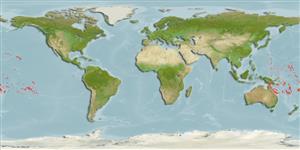Common names from other countries
Environment: milieu / climate zone / depth range / distribution range
экология
морской ассоциированный с рифами; пределы глубины 0 - 10 m (Ref. 89707), usually 0 - 3 m (Ref. 9710). Tropical; 30°N - 29°S, 139°E - 123°W (Ref. 5222)
Pacific Ocean: islands of Oceania; Ogasawara Islands, Marcus Islands, Mariana Islands, Marshall Islands, Phoenix Islands, American Samoa, Cook Islands, Line Islands, Society Islands, Rapa, Tuamoto Islands, and the Pitcairn Group. Unknown in Hawaii, the Marquesas, Caroline Islands, nor in any Melanesian islands.
Size / Вес / Возраст
Maturity: Lm ? range ? - ? cm
Max length : 52.0 cm TL самец/пол неопределен; (Ref. 9710)
колючие лучи спинного плавника (общее число) : 11; членистые (мягкие) лучи спинного плавника (общее число) : 14 - 16; колючие лучи анального плавника: 3; членистые (мягкие) лучи анального плавника: 8. Preopercle rounded, finely serrate; upper edge of the operculum sinuous; nostril subequal; maxilla reaches past vertical at rear edge of the eye. Pectoral fins fleshy. Head and body whitish, with small close-set blackish-brown spots, those on the rear part of the body coalesced to form irregular longitudinal bands. Four dark blotches usually at the base of the dorsal fin and a fifth forming a dark saddle blotch on the peduncle. Fins with small white spots and whitish margins, usually with a black submarginal band; body depth contained 2.9-3.4 times in SL; head length 2.4-2.6 times in SL (Ref. 89707).
This shallow-water species is more common on atolls than high islands, and usually found in exposed outer-reef areas. Not dependent on coral cover (Ref. 89707). Juveniles and occasionally adults are collected from tide pools. Feeds on crustaceans (mainly grapsid crabs), octopi, and fishes.
Life cycle and mating behavior
Maturities | размножение | Spawnings | Egg(s) | Fecundities | личинки
Heemstra, P.C. and J.E. Randall, 1993. FAO Species Catalogue. Vol. 16. Groupers of the world (family Serranidae, subfamily Epinephelinae). An annotated and illustrated catalogue of the grouper, rockcod, hind, coral grouper and lyretail species known to date. Rome: FAO. FAO Fish. Synop. 125(16):382 p. (Ref. 5222)
Статус Красного Списка МСОП (Ref. 130435)
CITES (Ref. 128078)
Not Evaluated
Угроза для людей
Harmless
Использование человеком
рыболовство: не имеет хозяйственного значения
дополнительная информация
инструменты
Специальные отчеты
Скачать в формате XML
ресурсы в Интернет
Estimates based on models
Preferred temperature (Ref.
115969): 25.4 - 29.4, mean 28.1 (based on 712 cells).
Phylogenetic diversity index (Ref.
82804): PD
50 = 0.5000 [Uniqueness, from 0.5 = low to 2.0 = high].
Bayesian length-weight: a=0.01175 (0.00571 - 0.02419), b=3.04 (2.88 - 3.20), in cm Total Length, based on LWR estimates for this Genus-body shape (Ref.
93245).
Trophic level (Ref.
69278): 4.2 ±0.64 se; based on food items.
устойчивость к внешним воздействиям (Ref.
120179): средний (среднего размера), минимальное время удвоения популяции 1.4-4.4 года (Preliminary K or Fecundity.).
Fishing Vulnerability (Ref.
59153): Moderate vulnerability (41 of 100).
